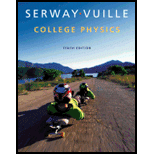
Choose the option from each pair that makes the following statement correct. According to an observer at rest, moving clocks run more [(a) slowly; (b) quickly] than stationary clocks and moving rods are [ (c) longer; (d) shorter] than stationary rods.
Answer to Problem 1CQ
According to an observer at rest, moving rods are (d) shorter than stationary rods.
Explanation of Solution
Time dilation: According to the theory of relativity, time dilation is a difference in the elapsed time measured by two observers, either due to a velocity difference relative to each other or by being differently situated relative to a gravitational field.
Length contraction: Length contraction is the phenomenon that a moving object’s length is measured to be shorter than its proper length, which is the length which is the length as measured in the object’s own rest frame.
Conclusion:
The time measured by the observer at the rest frame with the stationary clocks is the proper time. The proper time measured by the stationary clocks will be slower than the time measure in the moving clocks. Thus, the choice (b) is correct.
The time measured by the moving clocks will be shorter than the time measured by the stationary clocks according to the time dilation. Thus, the choice (a) is incorrect.
The length of the rod measured when it is at rest is its proper length. When the rod is moving with a speed near to the speed of light, the length will appear shorter according to the length contraction. Thus, the choice (d) is correct.
The length of a stationary rod measures according to the rest frame is longer compared to the moving rod with respect to the rest frame. Thus, the choice (c) is incorrect
Want to see more full solutions like this?
Chapter 26 Solutions
College Physics
- A capacitor with a capacitance of C = 5.95×10−5 F is charged by connecting it to a 12.5 −V battery. The capacitor is then disconnected from the battery and connected across an inductor with an inductance of L = 1.55 H . At the time 2.35×10−2 s after the connection to the inductor is made, what is the current in the inductor? At that time, how much electrical energy is stored in the inductor?arrow_forwardCan someone help me with this question. Thanks.arrow_forwardCan someone help me with this question. Thanks.arrow_forward
 Modern PhysicsPhysicsISBN:9781111794378Author:Raymond A. Serway, Clement J. Moses, Curt A. MoyerPublisher:Cengage Learning
Modern PhysicsPhysicsISBN:9781111794378Author:Raymond A. Serway, Clement J. Moses, Curt A. MoyerPublisher:Cengage Learning Physics for Scientists and Engineers: Foundations...PhysicsISBN:9781133939146Author:Katz, Debora M.Publisher:Cengage Learning
Physics for Scientists and Engineers: Foundations...PhysicsISBN:9781133939146Author:Katz, Debora M.Publisher:Cengage Learning University Physics Volume 3PhysicsISBN:9781938168185Author:William Moebs, Jeff SannyPublisher:OpenStax
University Physics Volume 3PhysicsISBN:9781938168185Author:William Moebs, Jeff SannyPublisher:OpenStax Principles of Physics: A Calculus-Based TextPhysicsISBN:9781133104261Author:Raymond A. Serway, John W. JewettPublisher:Cengage Learning
Principles of Physics: A Calculus-Based TextPhysicsISBN:9781133104261Author:Raymond A. Serway, John W. JewettPublisher:Cengage Learning Classical Dynamics of Particles and SystemsPhysicsISBN:9780534408961Author:Stephen T. Thornton, Jerry B. MarionPublisher:Cengage Learning
Classical Dynamics of Particles and SystemsPhysicsISBN:9780534408961Author:Stephen T. Thornton, Jerry B. MarionPublisher:Cengage Learning College PhysicsPhysicsISBN:9781305952300Author:Raymond A. Serway, Chris VuillePublisher:Cengage Learning
College PhysicsPhysicsISBN:9781305952300Author:Raymond A. Serway, Chris VuillePublisher:Cengage Learning





